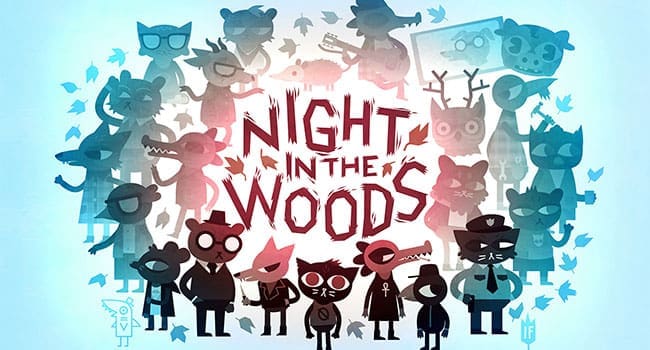Night in the Woods
Developer: Infinite Fall
Publisher: Finji
ESRB Rating: Teen
Platform: PC, PlayStation 4
Cost: $20
 Night in the Woods is one of the most compelling games I’ve played in a long while. There are so many things to recommend it, I hardly know where to begin. But here goes.
Night in the Woods is one of the most compelling games I’ve played in a long while. There are so many things to recommend it, I hardly know where to begin. But here goes.
This is a beautiful game, in both the aesthetics that make its world come alive, and in its weaving of story and characters within that world.
Giving the elevator pitch for this game must have been a challenge because it’s about so many things that it’s hard to pin down. It’s about the vibrant pulse of a small town and the lives of the diverse, lovable people who occupy it. It’s about the meaning of true friendship and the heartbreak that can accompany it. It’s about depression. The list goes on, yet the subject matter, much of which is emotionally heavy, is expressed within a story that often has such a spring in its step that you don’t know what you’re into until it’s right in your face.
You are Mae, a 20-year-old college dropout just returning by train to her hometown of Possum Springs. She’s not quite ready to return, nor to face the people there. She’s also an anthropomorphic cat person. The denizens of this world are all anthropomorphic somethings. In this world, people of all sorts of races (animals) live side by side happily. And issues of sexual choice never arise even though there are plenty of people of various inclinations. There’s an unquestioning acceptance that speaks volumes about what the game’s creators believe is possible.
As you explore Possum Springs, running into people from Mae’s past, you reveal more about this town and its inhabitants. As you progress, new parts of the town become accessible. You hop around on power lines and deftly leap from rooftop to rooftop. As I met characters, I began to see approximations of people from my life. People I might slot into this or that archetype a little too easily. Yet as you learn more about these people, you discover there’s much more to them than you first thought. I found something to like about every one of them and it made me challenge my real-life assumptions.
Night in the Woods, then, resonates on a personal level. The secondary cast of townsfolk are interesting and likable, often having important personal stories to tell. But it was Mae’s core group of friends and family who most frequently touched me. You would be hard-pressed not to find something relatable about these people and their struggles. Their stories are written so honestly and the dialogue feels so deeply truthful that you can’t avoid connection.
Many things spoke to me: Mae bumbling through an awkward phase of not fitting in with kids or adults, and trying to find her own niche; one character’s view of their partner who, after growing up in a challenging setting, still managed to become beautifully inspiring; the same character describing how they sometimes lay next to their partner at night, wondering how they’re able to cast the world around them in such a bright light of positivity.
Night in the Woods’ true strength is its subtle, deft ability to touch you. Maybe you’re a parent struggling with a challenging teen or you were (or are) that teen. Perhaps you’ve dealt with abuse or know someone who has. Even if your struggles haven’t been quite so tough, you’ll still find a story here that means something to you.
Each day you can explore the town and speak to people. And every day, something is happening, big or small, with most everyone. Each day ends with some sort of event. Often you choose between a couple things. The daytime explorations and evening events are punctuated by small games, which range from a basic rhythm game to a friendly knife fight with your pal. The events at the end of each day most often include going to some otherwise inaccessible location to do something with one of your friends, and along the way being rewarded with meaningful character development.
Each night, Mae dreams. You have control of her here and her dreams usually consist of her desperately trying to put something together, although different dreams occur a few times. No spoilers, but her dreams hint a a deeper crisis she’s having and boy, do they go places.
In Mae’s attempts to reconnect to her hometown, she and her friends make a grisly discovery. This sets off the larger story arc. Although it’s engrossing, scary and ends with a satisfying payoff, the real stars of the narrative are the smaller, personal stories.
One brilliant part of the game, which manifests itself most frequently in the dreams, is the audio. The music is fairly good throughout but it was often the moments with a lack of music that really struck me. Night in the Woods can truly creep you out with its visuals and particularly with its audio. The background noises mixed with slowly-building, foreboding music (or lack thereof) provided some of the best/worst unsettling vibes I’ve felt from a game in a long time.
I had few gripes, one of them from the mini games. Most of these are just one-off moments and barely any control explanation is given. I can understand that the story arc would be interrupted if we stopped for tutorials. But it sometimes left me frustrated and stumbling with what I was supposed to do. I would be left wondering if I could have done better and what would have happened if I had.
But this is a brilliant game. I can’t remember the last time I played a game that hit me in so many personal ways, and I don’t think I’ve ever played a game this well written. A game that can seamlessly weave one person’s very personal story of depression with a murder mystery, and surround it all with some of the most fun and truthful characters I’ve ever encountered is more than deserving of the title of Sam’s Favourite Game He’s Played So Far This Year.
Troy Media columnist Sam Stewart, an actor, has a diploma in theatre studies and a degree film studies. He also works in the tech industry and loves to indulge his lifelong passion for video games, from the classics to new releases. He tries to look at video games from a broad perspective: as a gamer, but also as someone who wants to know what a game is telling its audience, how it’s advancing the genre and industry, and how it challenges the player.
The views, opinions and positions expressed by columnists and contributors are the author’s alone. They do not inherently or expressly reflect the views, opinions and/or positions of our publication.


